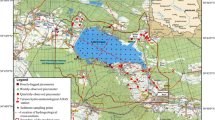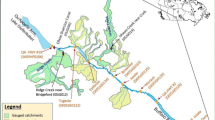Abstract
Controlling phosphorus is fundamental to limit the risk of eutrophication of continental aquatic ecosystems. Integrated modelling of its concentration in the aquatic continuum requires specific tools for water bodies. However, although simple static empirical models and complex biogeochemical models are numerous, there are few relatively simple and flexible models able to simulate seasonal variations in phosphorus concentrations in water bodies and particularly in reservoirs. In this study, the two-layer dynamic model, LakeMab, simulating phosphorus variations in water bodies, was enhanced to consider some tributary characteristics and reservoir specificities. It was then applied to the case of a reservoir in western France, Lake Bultière. Without any calibration, the modified model reproduced reasonably well seasonal variations in phosphorus concentration in the lake. A sensitivity analysis showed the importance of improvements related to reservoir functioning (outlet depth, water level fluctuations) and the smaller importance of those related to tributaries (variable concentrations, depth of riverine inputs). The model can easily be applied to diverse lentic systems and could be coupled to stream models, thereby making it a useful tool for managing water quality in lakes and reservoirs.







Similar content being viewed by others
References
Abrahamsson O, Håkanson L (1998) Modelling seasonal flow variability of European rivers. Ecol Model 114:49–58
Armengol J, Garcia JC, Comerma M, Romero M, Dolz J, Roura M, Han B-H, Vidal A, Šimek K (1999) Longitudinal processes in canyon type reservoirs: the case of Sau (N. E. Spain). In: Tundisi JG, Straškraba M (eds) Theoretical reservoir ecology and its applications. Brazilian Academy of Sciences and Backhuys Publishers, Saõ Carlos, pp 313–345
Bryhn AC, Håkanson L (2007) A comparison of predictive phosphorus load-concentration models for lakes. Ecosystems 10:1084–1099
Cardoso AC, Free G, Nõges P, Kaste Ø, Poikane S, Solheim AL (2009) Lake management, criteria. In: Likens GE (ed) Encyclopedia of inland waters. Oxford, pp 310–331. https://doi.org/10.1016/B978-012370626-3.00244-1
Carpenter SR, Ludwig D, Brock WA (1999) Management of eutrophication for lakes subject to potentially irreversible change. Ecol Appl 9:751–771
Carvalho L, Poikane S, Solheim AL, Phillips G, Borics G, Catalan J, De Hoyos C, Drakare S, Dudley BJ, Jarvinen M, Laplace-Treyture C, Maileht K, McDonald C, Mischke U, Moe J, Morabito G, Noges P, Noges T, Ott I, Pasztaleniec A, Skjelbred B, Thackeray SJ (2013) Strength and uncertainty of phytoplankton metrics for assessing eutrophication impacts in lakes. Hydrobiologia 704:127–140
Downing JA, Watson SB, McCauley E (2001) Predicting cyanobacteria dominance in lakes. Can J Fish Aquat Sci 58:1905–1908
Elser J, Bennett E (2011) A broken biogeochemical cycle. Nature 478:29
European Commission (2000) Directive 2000/60/EC of the European Parliament and of the Council of 23 October 2000 establishing a framework for community action in the field of water policy. The European Parliament and Council, p 72
Håkanson L (2005) The importance of lake morphometry for the structure and function of lakes. Int Rev Hydrobiol 90:433–461
Håkanson L (2000) Modelling radiocesium in lakes and coastal areas- new approaches for ecosystem modellers. A textbook with Internet support. Kluwer, Dordrecht
Håkanson L (2006) Suspended particulate matter in lakes, rivers and marine systems. Blackburn, New Jersey
Håkanson L, Boulion V (2002) The Lake Foodweb: modelling predation and abiotic/biotic interactions. Backhuys Publishers, Leiden
Håkanson L, Bryhn AC (2008) A dynamic mass-balance model for phosphorus in lakes with a focus on criteria for applicability and boundary conditions. Water Air Soil Pollut 187:119–147
Hirsch RM, Moyer DL, Archfield SA (2010) Weighted regressions on time, discharge, and season (WRTDS), with an application to Chesapeake Bay River Inputs. J Am Water Resour Assoc 46:857–880
Janssen ABG, Arhonditsis GB, Beusen A, Bolding K, Bruce L, Bruggeman J, Couture R-M et al (2015) Exploring, exploiting and evolving diversity of aquatic ecosystem models: a community perspective. Aquat Ecol 49:513–548
Janssen ABG, Teurlincx S, Beusen AHW, Huijbregts MAJ, Rost J, Schipper AM, Seelen LMS et al (2019) PCLake+: A process-based ecological model to assess the trophic state of stratified and non-stratified freshwater lakes worldwide. Ecol Model 396:23–32
Johansson H, Brolin AA, Håkanson L (2007) New approaches to the modelling of lake basin morphometry. Environ Model Assess 12:213–228
Kettle H, Thompson R, Anderson NJ, Livingstone DM (2004) Empirical modeling of summer lake surface temperatures in southwest Greenland. Limnol Oceanogr 49:271–282
Laplace-Treyture C, Feret T (2016) Performance of the Phytoplankton Index for Lakes (IPLAC): a multimetric phytoplankton index to assess the ecological status of water bodies in France. Ecol Indic 69:686–698
Lehman EM, McDonald KE, Lehman JT (2009) Whole lake selective withdrawal experiment to control harmful cyanobacteria in an urban impoundment. Water Res 43:1187–1198
Marcé R, Moreno-Ostos E, García-Barcina JM, Armengol J (2010) Tailoring dam structures to water quality predictions in new reservoir projects: Assisting decision-making using numerical modeling. J Environ Manage 91:1255–1267
Markofsky M, Harleman DRF (1971) A predictive model for thermal stratification and water quality in reservoirs. M.I.T, Hydrodynamics Laboratory, Boston
Moatar F, Abbott BW, Minaudo C, Curie F, Pinay G (2017) Elemental properties, hydrology, and biology interact to shape concentration-discharge curves for carbon, nutrients, sediment, and major ions. Water Resour Res 53:1270–1287
Mohseni O, Stefan HG, Erickson TR (1998) A nonlinear regression model for weekly stream temperatures. Water Resour Res 34:2685–2692
Mooij WM, Trolle D, Jeppesen E, Arhonditsis G, Belolipetsky PV, Chitamwebwa DBR, Degermendzhy AG et al (2010) Challenges and opportunities for integrating lake ecosystem modelling approaches. Aquat Ecol 44:633–667
Ottosson F, Abrahamsson O (1998) Presentation and analysis of a model simulating epilimnetic and hypolimnetic temperatures in lakes. Ecol Model 110:233–253
Paerl HW, Hall NS, Calandrino ES (2011) Controlling harmful cyanobacterial blooms in a world experiencing anthropogenic and climatic-induced change. Sci Total Environ 409:1739–1745
Palau A (2006) Integrated environmental management of current reservoirs and regulated rivers. Limnetica 25:287–302
Phillips G, Pietilainen OP, Carvalho L, Solimini A, Solheim AL, Cardoso AC (2008) Chlorophyll-nutrient relationships of different lake types using a large European dataset. Aquat Ecol 42:213–226
Prats J, Danis P-A (2019) An epilimnion and hypolimnion temperature model based on air temperature and lake characteristics. Knowl Manag Aquat Ecosyst 420:8
Prats J, Salencon MJ, Gant M, Danis P-A (2018) Simulation of the hydrodynamic behaviour of a Mediterranean reservoir under different climate change and management scenarios. J Limnol 77:62–81
Prats Rodríguez J, Danis P-A (2017) Epi- and hypolimnion temperature evolution in lakes belonging to the national WFD network (Évolutions des températures de l'épilimnion et de l'hypolimnion des plans d'eau DCE nationaux). Agence Française pour la biodiversité, Aix-en-Provence
Roubeix V, Danis P-A, Feret T, Baudoin J-M (2016) Identification of ecological thresholds from variations in phytoplankton communities among lakes: contribution to the definition of environmental standards. Environ Monit Assess 188:246
R Core Team (2018) R: A language and environment for statistical computing. R Foundation for Statistical Computing, Vienna. https://www.R-project.org/
Schindler DW (1974) Eutrophication and recovery in experimental lakes: implications for Lake Management. Science 184:897–899
Smith VH (2003) Eutrophication of freshwater and coastal marine ecosystems a global problem. Environ Sci Pollut Res Int 10:126–139
Smith VH, Tilman GD, Nekola JC (1999) Eutrophication: impacts of excess nutrient inputs on freshwater, marine, and terrestrial ecosystems. Environ Pollut 100:179–196
Soetaert K, Petzoldt T, Woodrow Setzer R (2010) Solving differential equations in R: package deSolve. J Stat Softw 33:1–25
Søndergaard M, Jensen JP, Jeppesen E (2003) Role of sediment and internal loading of phosphorus in shallow lakes. Hydrobiol 506:135–145
Vidal JP, Martin E, Franchisteguy L, Baillon M, Soubeyroux JM (2010) A 50-year high-resolution atmospheric reanalysis over France with the Safran system. Int J Climatol 30:1627–1644
Vollenweider RA (1968) The scientific basis oflake eutrophication, with particular reference to phosphorus and nitrogen as eutrophication factors Water management research. OECD, Paris
Vollenweider RA (1975) Input-output models—with special reference to the phoshorus loading concept in limnology. Schweiz Z Hydrol 37:53–84
Weber M, Rinke K, Hipsey MR, Boehrer B (2017) Optimizing withdrawal from drinking water reservoirs to reduce downstream temperature pollution and reservoir hypoxia. J Environ Manage 197:96–105
Windolf J, Jeppesen E, Jensen JP, Kristensen P (1996) Modelling of seasonal variation in nitrogen retention and in-lake concentration: a four-year mass balance study in 16 shallow Danish lakes. Biogeochemistry 33:25–44
Zhang Q (2018) Synthesis of nutrient and sediment export patterns in the Chesapeake Bay watershed: complex and non-stationary concentration-discharge relationships. Sci Total Environ 618:1268–1283
Zhang Q, Harman CJ, Ball WP (2016) An improved method for interpretation of riverine concentration-discharge relationships indicates long-term shifts in reservoir sediment trapping. Geophys Res Lett 43:10215–10224
Acknowledgements
This research was funded by Agence Française pour la Biodiversité. The authors are grateful to Vendée Eau for useful information about Lake Bultière.
Author information
Authors and Affiliations
Corresponding author
Additional information
Publisher's Note
Springer Nature remains neutral with regard to jurisdictional claims in published maps and institutional affiliations.
Handling Edior: Haw Yen.
Electronic supplementary material
Below is the link to the electronic supplementary material.
Rights and permissions
About this article
Cite this article
Roubeix, V., Minaudo, C., Prats, J. et al. Adapting the dynamic LakeMab model to simulate seasonal variations of phosphorus concentration in reservoirs: a case study of Lake Bultière (France). Limnology 21, 233–244 (2020). https://doi.org/10.1007/s10201-019-00606-x
Received:
Accepted:
Published:
Issue Date:
DOI: https://doi.org/10.1007/s10201-019-00606-x




